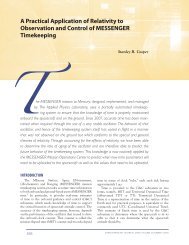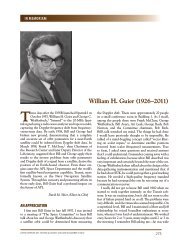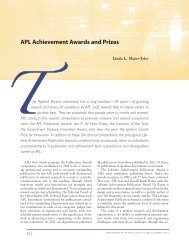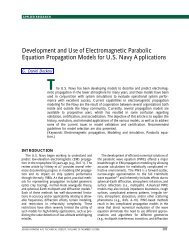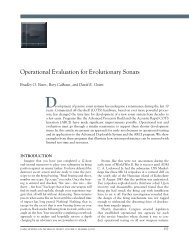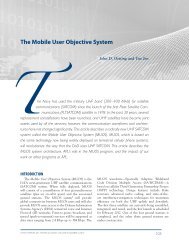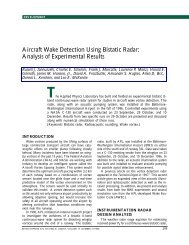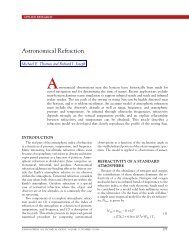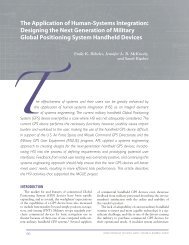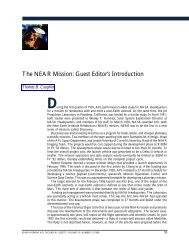The SATRACK System: Development and Applications
The SATRACK System: Development and Applications
The SATRACK System: Development and Applications
Create successful ePaper yourself
Turn your PDF publications into a flip-book with our unique Google optimized e-Paper software.
patterns. To minimize the problems associated with<br />
removing antenna phase effects in the postprocessor,<br />
opposite pairs of antennas were summed to form twoelement<br />
interferometers oriented 90° from each other.<br />
<strong>The</strong> translator input was time multiplexed between<br />
the two interferometers. <strong>The</strong> time multiplex rate was<br />
set high enough to be outside the b<strong>and</strong>width of the<br />
signal tracking loops so that both inputs could be<br />
tracked simultaneously when the signals were strong<br />
enough. However, the tracking data used by the system’s<br />
Kalman filter were selected to include only tracking<br />
data from the regions of each antenna where the<br />
phase effects were well understood (i.e., away from the<br />
null regions). Although this was a reasonable compromise<br />
within the set constraints, it led to an antenna<br />
design with a very poor gain over a large region (i.e.,<br />
the specified gain was more than 14 dB below an ideal<br />
isotropic antenna, 0 dBi, over 15% of the coverage<br />
region). This poor gain, coupled with the levels of GPS<br />
satellite signals, represented a challenging condition<br />
for signal tracking.<br />
Signal refraction through the ionosphere at the<br />
GPS prime frequency (L 1 = 1575.42 MHz) is significant,<br />
<strong>and</strong> it must be corrected for precision positioning<br />
applications. GPS provides a second frequency signal<br />
(L 2 = 1227.60 MHz) that is used with the prime frequency<br />
to compute the needed correction for signal<br />
refraction. Modulations applied to each frequency<br />
provide the basis for epoch measurements used to<br />
determine the distance to each satellite (range measurements).<br />
Two range-code modulations are applied<br />
to the L 1 frequency, one having a 2-MHz b<strong>and</strong>width<br />
<strong>and</strong> a second having a 20-MHz b<strong>and</strong>width. <strong>The</strong> L 2<br />
frequency, however, is modulated only with the 20-<br />
MHz b<strong>and</strong>width ranging code.<br />
<strong>The</strong> strongest GPS signal is the narrow-b<strong>and</strong>width<br />
L 1 signal; the L 2 signal is at one-fourth the power level<br />
of the L 1 signal. <strong>The</strong> wide b<strong>and</strong>width <strong>and</strong> lower power<br />
characteristics of the L 2 signal, combined with the<br />
antenna constraints for C4, precluded its use in the<br />
<strong>SATRACK</strong> I system. <strong>The</strong>rfore, the C4 translator was<br />
designed to use only the narrow-b<strong>and</strong>width GPS signal.<br />
<strong>The</strong> narrow b<strong>and</strong>width code signal is referred to<br />
as the clear/acquisition (C/A) code, <strong>and</strong> the wideb<strong>and</strong>width<br />
code is normally referred to as the protected<br />
or precision (P) code. Sometimes the P code is called<br />
the P/Y code to indicate that the P code is encrypted.<br />
Since the C4 translator would be using only the<br />
GPS L 1 C/A signal, another means was needed to<br />
correct for ionospheric refraction. Because of our development<br />
of <strong>and</strong> operational experience with Transit,<br />
we had an extensive background in ionospheric science.<br />
We had developed <strong>and</strong> evaluated models of the<br />
ionosphere, <strong>and</strong> we understood their limitations. We<br />
therefore decided to provide a ground-based satellitelike<br />
transmitter (i.e., a pseudosatellite) with two<br />
THE <strong>SATRACK</strong> SYSTEM<br />
frequencies. Measurements of these two signals yielded<br />
a measure of refraction along the signal path between<br />
the missile <strong>and</strong> the pseudosatellite. <strong>The</strong>se data gave an<br />
estimate of the electron density profile in the region<br />
of the missile flight path. <strong>The</strong> profile was then used to<br />
adjust our best available ionosphere model, which was<br />
then applied to estimate the refraction correction for<br />
each GPS satellite-to-missile L 1 signal path. <strong>The</strong> primary<br />
pseudosatellite signal is similar to the GPS L 1<br />
signal. <strong>The</strong> second pseudosatellite signal was set at<br />
one-fourth the L 1 signal frequency (the L 1/4 signal),<br />
<strong>and</strong> it was modulated with a 200-KHz b<strong>and</strong>width ranging<br />
code. Another natural use of the L 1/4 signal was<br />
for SLBM range safety. By adding extra L 1/4 pseudosatellites<br />
at selected range sites, the required (loweraccuracy)<br />
real-time trajectory measurement is determined<br />
in relation to the three or more pseudosatellite<br />
locations. This range safety system was qualified during<br />
early C4 flights, which were equipped with both translators<br />
<strong>and</strong> C-b<strong>and</strong> radar transponders. (Although the<br />
range safety system shares components with SA-<br />
TRACK, it is normally treated as a separate system <strong>and</strong><br />
we will not discuss it further.)<br />
<strong>The</strong> Laboratory provided overall technical direction<br />
for the <strong>SATRACK</strong> system <strong>and</strong> developed <strong>and</strong><br />
continues to operate the unique postflight processing<br />
subsystem. Missile hardware development was part of<br />
the Navy’s missile development contract with Lockheed<br />
Missiles <strong>and</strong> Space Company, <strong>and</strong> the ground<br />
recording <strong>and</strong> range safety equipment development<br />
was added to the Navy’s contract with Interstate Electronics<br />
Corporation.<br />
Another major challenge in <strong>SATRACK</strong> development<br />
was implementation of the large Kalman filter<br />
processing technique. To get a head start on developing<br />
the required C4 postflight processing software, the<br />
proposed methodology was applied to radar data collected<br />
for Poseidon (C3) missile flight tests. We recognized<br />
from the outset that the radar data would be<br />
inadequate because of shortfalls in system geometry<br />
<strong>and</strong> velocity measurement accuracy; however, valuable<br />
analysis insights <strong>and</strong> practical experience would be<br />
gained in the process. <strong>The</strong> C3 processing would be<br />
applied to data available from selected earlier Demonstration<br />
<strong>and</strong> Shakedown Operation (DASO) flight<br />
tests <strong>and</strong> all subsequent C3 DASOs (after March<br />
1975) until the beginning of the C4 Missile Flight Test<br />
Program. DASOs were selected because the radar geometry<br />
was very weak in the operational test area.<br />
An improved tracking capability was subsequently<br />
added to collect Doppler data from missile telemetry<br />
signals to supplement the radar data. This capability,<br />
called the Telemetry Doppler Metric Measurement<br />
<strong>System</strong> (TDMMS), was based on the use of telemetry<br />
signal Doppler differences as observed at multiple receiving<br />
sites. <strong>The</strong> hardware to record these data for<br />
JOHNS HOPKINS APL TECHNICAL DIGEST, VOLUME 19, NUMBER 4 (1998) 441




